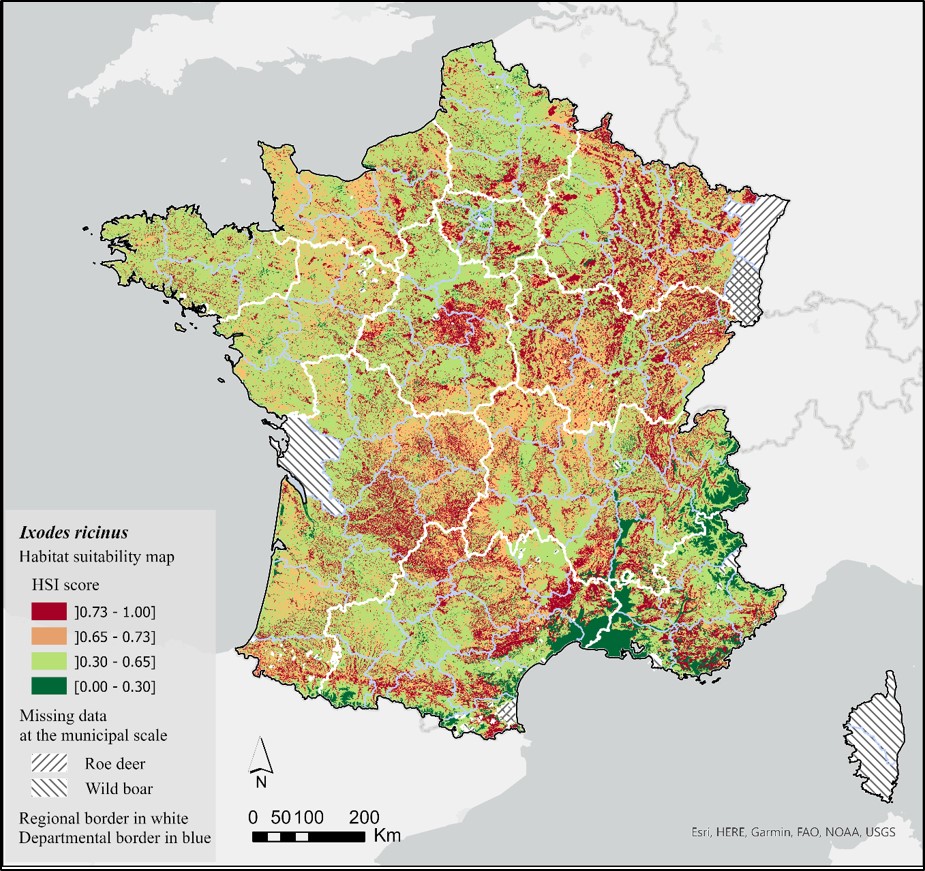Food, Global Health Reading time 2 min
Meteorological maps to help predict tick activity
Published on 01 June 2022

Mapping areas prone to tick activity
In France, Ixodes ricinus is present throughout most of the country and is the main vector of tick-borne diseases such as Lyme disease. The activity and life cycle of ticks depend on many environmental factors such as climate (oceanic, Mediterranean, continental, etc.), altitude, land use (forests, meadows, urban areas, etc.) and the presence of hosts. A rating ranging from "unfavourable" to "very favourable" was assigned to each of these four factors, the presence of hosts being assessed according to the density of wild ungulates (data from the French Biodiversity Agency). The research team combined their knowledge of such factors using multi-criteria decision analysis, which they applied to geographic information systems in order to create a map that would indicate the most favourable habitats for Ixodes ricinus.

To validate this approach, they compared the map’s predictions to field data obtained through nymph sampling campaigns carried out in France. The map confirms that the most favourable areas for ticks are in the centre, north-east and south-west parts of the country, while the least favourable habitats are the Mediterranean and high mountain regions. This map provides valuable information for regions and municipalities and will be useful to better target prevention campaigns against ticks.
A model to predict tick activity according to the weather
Tick activity is also determined by weather conditions, which have an impact on the risk of pathogen transmission, including those responsible for Lyme disease. To better understand and describe tick activity, researchers used data from a network of 7 sites in mainland France. Since 2014, monthly sampling campaigns have been organised in these observatories to estimate tick density, but also to measure meteorological (temperature, humidity, etc.) and environmental variables (altitude, land use, etc.). By consolidating the information from 631 sampling campaigns, they were able to develop a statistical model to estimate tick activity according to location, season, and meteorological variables. This model can explain most of the fluctuations previously observed in tick activity.
Together, the map and the model provide valuable information to identify regions and periods with high tick exposure risk in France. The objective is to be able to combine the two in order to produce maps of tick activity for metropolitan France, based on meteorological data.
REfErences
Isabelle Lebert, Séverine Bord, Christine Saint-Andrieux, Eva Cassar, Patrick Gasqui, Frédéric Beugnet, Karine Chalvet-Monfray, Sophie O. Vanwambeke, Gwenaël Vourc'h, Magalie René-Martellet. 2022. Habitat suitability map of Ixodes ricinus tick in France using multi-criteria analysis. Geospatial Health, Vol.17 n°1 (2022) DOI: https://doi.org/10.4081/gh.2022.1058
Wongnak P, Bord S, Jacquot M, Agoulon A, Beugnet F, Bournez L, Cèbe N, Chevalier A, Cosson JF, Dambrine N, Hoch T, Huard F, Korboulewsky N, Lebert I, Madouasse A, Mårel A, Moutailler S, Plantard O, Pollet T, Poux V, René‑Martellet M, Vayssier‑Taussat M, Verheyden H, Vourc’h G, Chalvet‑Monfray K, 2022. Meteorological and climatic variables predict the phenology of Ixodes ricinus nymph activity in France, accounting for habitat heterogeneity. Scientific Reports 12, no 1: 7833. https://doi.org/10.1038/s41598-022-11479-z
press Contacts
- INRAE Press office: presse@inrae.fr
- VetAgro Sup Press office: communication@vetagro-sup.fr
- ANSES Press office: presse@anses.fr
- Boehringer Ingelheim: isabelle.emerard@boehringer-ingelheim.com
